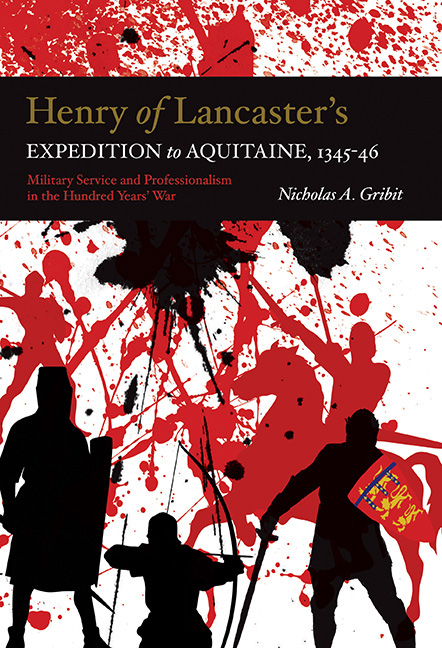 Henry of Lancaster's Expedition to Aquitaine, 1345-1346
Henry of Lancaster's Expedition to Aquitaine, 1345-1346 from Part II - The English Expedition to Aquitaine, 1345–46
Published online by Cambridge University Press: 05 July 2016
The Siege of Aiguillon
At the beginning of 1346, the French army in Aquitaine and the surrounding regions was in disarray following the English acquisition of territory, and by March its possessions were restricted to a few major strongholds. In response to Lancaster's military success and territorial gains the French raised an army of an unprecedented size for the southern theatre of war. The army that Philippe VI provided for his son, Jean, duke of Normandy, was the result of a period of intense military recruitment financed by papal loans and taxation of the communities in the south. Soldiers were recruited from various regions in France and crossbowmen were hired from Aragon and Genoa. It is difficult to determine the size or composition of the entire French army; from among the vast range of numbers given by the chroniclers, it seems reasonable to estimate that the army numbered somewhere between the 10,000 given by Robert Avesbury and the 30,000 recorded in the Récits d'un bourgeois de Valenciennes. This huge force was led by no fewer than twenty-one counts and another thirty-one noblemen.
The main army under Normandy's command comprised an array of northern lords, including Pierre, duke of Bourbon, Eudes IV, duke of Burgundy, and Gautier of Brienne, duke of Athens, as well as Jean, count of Boulogne, Bouchard, count of Vendôme and Charles, count of Joigny. They were augmented by the military officers of the royal household: Raoul II, constable of France and count of Eu, and both marshals and the master of the Royal Archers. A second army assembled at Toulouse at the instance of Jean de Marigny, bishop of Beauvais, which included nobility drawn from the southern seneschalcies, such as Jean, count of Armagnac, Pierre- Ramond, count of Comminges, and Gaston Fébus, count of Foix. The French force which mustered in the south brought with it a train of siege equipment, including five cannons; considering the weight and size of such equipment it made logistical sense for it to be brought by the southern army which was located closer to the intended theatre of war than its northern counterpart.
To save this book to your Kindle, first ensure [email protected] is added to your Approved Personal Document E-mail List under your Personal Document Settings on the Manage Your Content and Devices page of your Amazon account. Then enter the ‘name’ part of your Kindle email address below. Find out more about saving to your Kindle.
Note you can select to save to either the @free.kindle.com or @kindle.com variations. ‘@free.kindle.com’ emails are free but can only be saved to your device when it is connected to wi-fi. ‘@kindle.com’ emails can be delivered even when you are not connected to wi-fi, but note that service fees apply.
Find out more about the Kindle Personal Document Service.
To save content items to your account, please confirm that you agree to abide by our usage policies. If this is the first time you use this feature, you will be asked to authorise Cambridge Core to connect with your account. Find out more about saving content to Dropbox.
To save content items to your account, please confirm that you agree to abide by our usage policies. If this is the first time you use this feature, you will be asked to authorise Cambridge Core to connect with your account. Find out more about saving content to Google Drive.